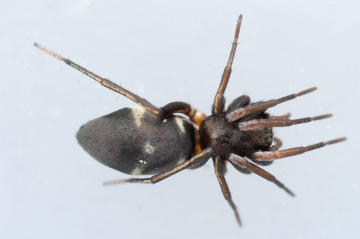Summary for Micaria silesiaca (Araneae)
previous species | next species
National Distribution
Terms of Use. Double-click on map to go to region

Explore Regional Distribution
Please log on and add a note on this species
About this species
Recorded altitude range5m to 140m
Species text
DistributionThe species is confined to the southern half of England. It is widespread in north-western and central Europe, but has not been recorded from Ireland.
Habitat and ecology
M. silesiaca occurs on sparsely vegetated heathland, reaching maximum densities in about the second or third year after fire, and disappearing by about 10 years after fire. It is found mainly on dry heath, but is also present on moderately wet heath and in damp gullies. It is an ant-mimic, sometimes found in association with ants. Males are adult from late May to early July, females also until August.
Status
The spider is never all that common. It may occur in quite small numbers on fairly recently burnt heathland in Dorset, Hampshire and Surrey, and on open, sandy Breckland heaths in Suffolk, but is scarce elsewhere. It is known from seven locations since 1992 and records suggest a major decline since the 1960s and 70s. Area of occupancy has apparently declined by 63% from 19 hectads prior to 1992 to only seven since then. Trend analysis of the continuing decline in area of occupancy over the period 1976 to 2005 indicates a reduction in population size of 39% over a ten year period.
Threats
The loss of heathland to agriculture, afforestation and development. The growth of scrub, and lack of open areas.
Management and conservation
Maintain all seral stages of heather by rotational burning. A regular supply of naturally open sandy areas or recently burnt areas is required by this species. Residual populations probably survive on firebreaks, sandy banks, gullies, etc, from where they spread to burnt areas.
Text based on Dawson, I.K., Harvey, P.R., Merrett, P. & Russell-Smith, A.R. (in prep.). References
Adult Season
Habitats
background methodology
Recorded management for locations with Micaria silesiaca
Recorded substrate and hydrology for locations with Micaria silesiaca
Images
please log on and upload a new image for this speciesSee also A-Z Species Index - A-Z Picture Index - previous species | next species
